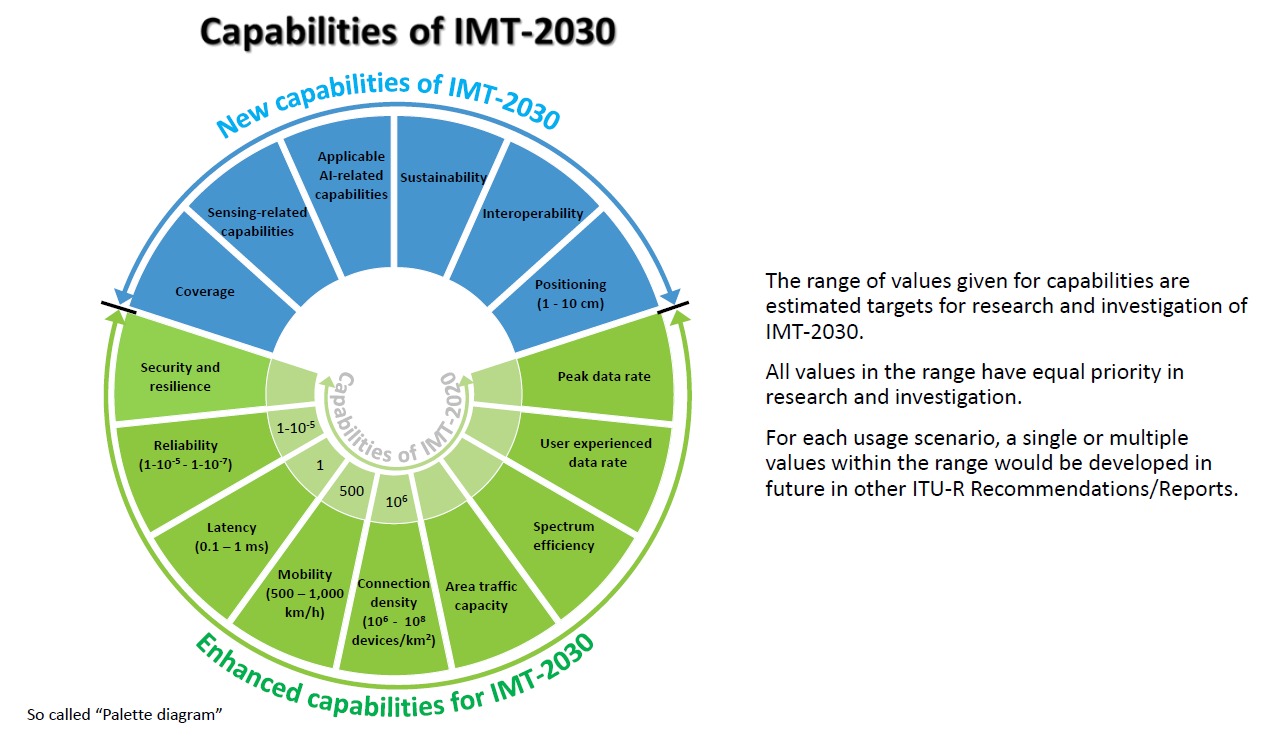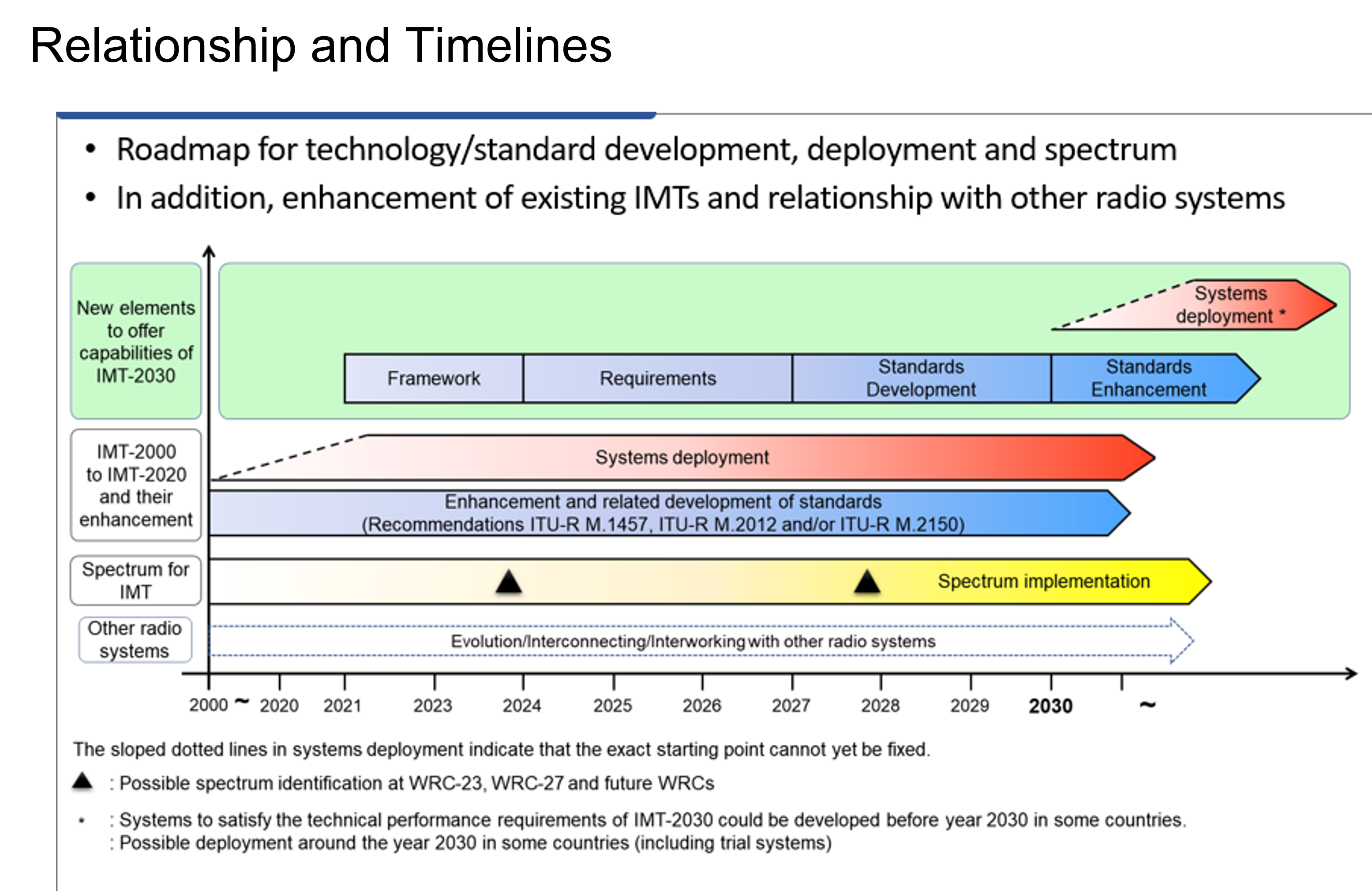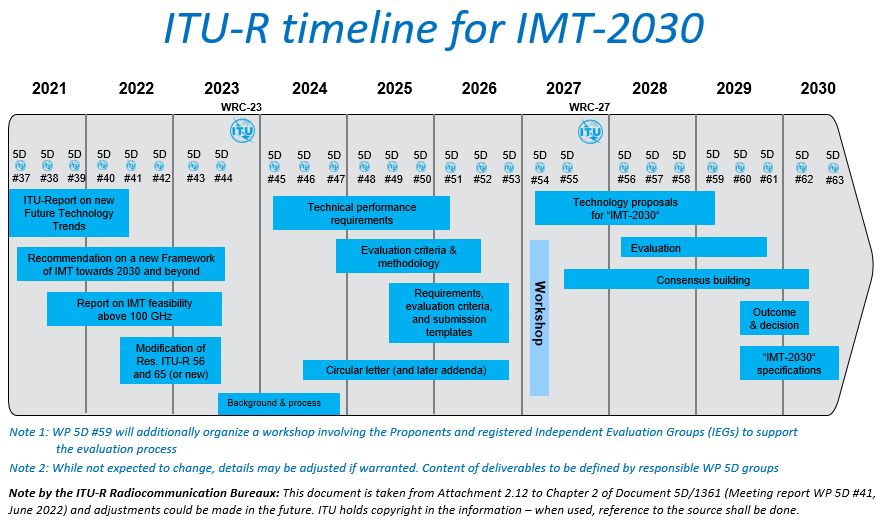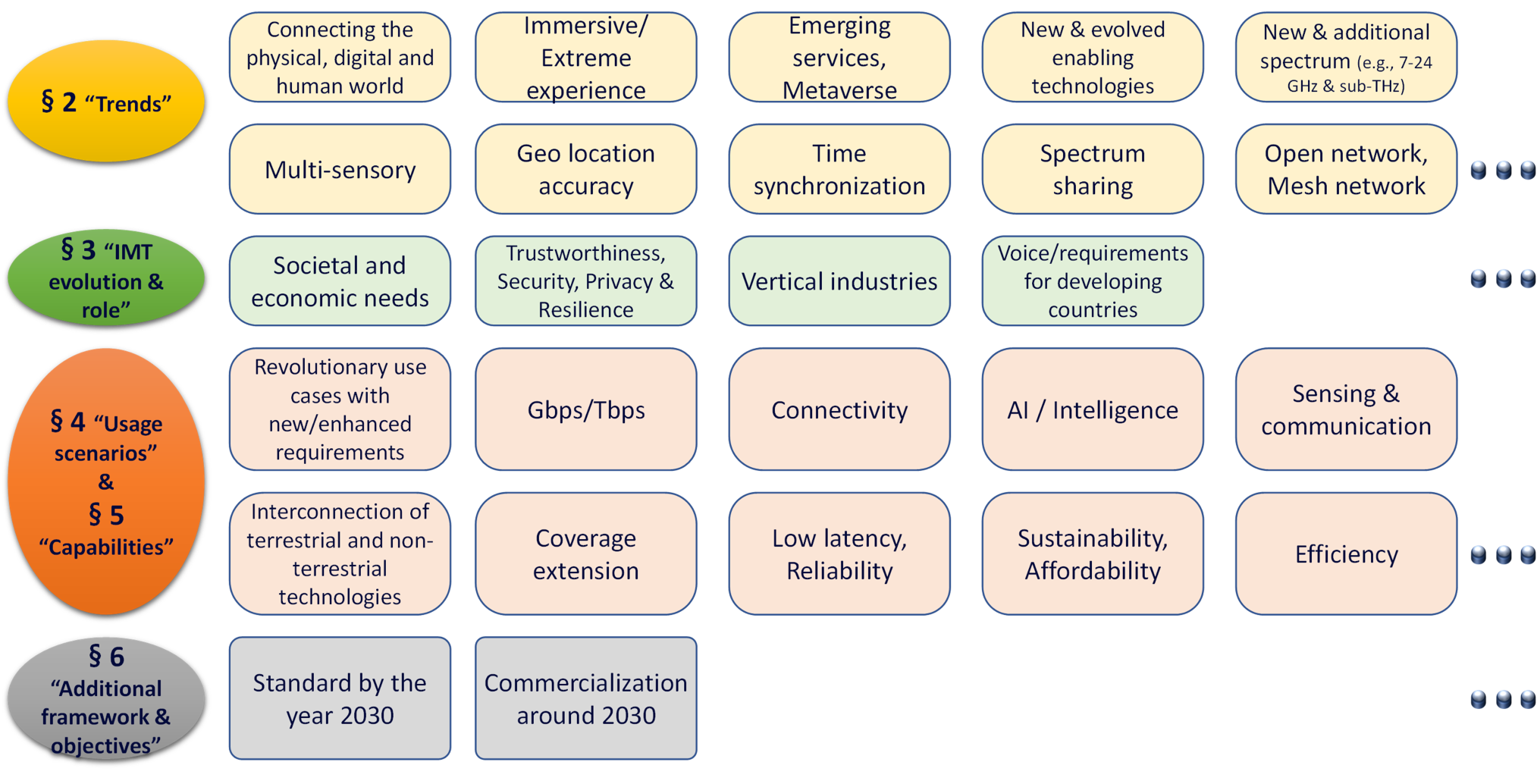
IMT towards 2030 and beyond (IMT-2030)
New Report ITU-R M.2541 “Technical feasibility of IMT in bands above 100 GHz” has been published (May 2024)
At its first meeting in 2024, ITU-R SG 5 approved a new Report ITU-R M.2541 about the “Technical feasibility of IMT in bands above 100 GHz”, which includes information on propagation mechanisms and channel models, as well as newly developed technology enablers such as active and passive components, antenna techniques, deployment architectures, and the results of simulations and performance tests. As such, it complements Report ITU-R M.2376 containing studies for the frequency ranges 6-100 GHz.
New Recommendation ITU-R M.2160 on the “IMT-2030 Framework” (November 2023)
The Radiocommunication Assembly 2023 (RA-23) approved the revisions of Resolution ITU-R 56, confirming the name for the next generation of IMT (aka “6G”) to be “IMT-2030” and Resolution ITU-R 65, which describes the principles of the IMT-process. Along these revisions, RA-23 also approved the new Recommendation on the “IMT-2030 Framework”, which will now become Recommendation ITU-R M. 2160.
Together with the already existing Report on “Future Technology Trends” ITU-R M.2516 (see below), this marks the achievement of the initial phase, setting the basis for the development of IMT-2030. The next phase (2024-2027) will be the definition of relevant requirements and evaluation criteria for potential radio interface technologies (RIT) for IMT-2030 – (see “ITU-R timeline for IMT-2030” below).
With the evolution of information and communications technologies, IMT-2030 is expected to support enriched and potential immersive experience, enhanced ubiquitous coverage, and enable new forms of collaboration. Furthermore, IMT-2030 is envisaged to support expanded and new usage scenarios compared to those of IMT-2020, while providing enhanced and new capabilities.
IMT-2030 is further expected to help address the need for increased environmental, social, and economic sustainability, and also support the goals of the Paris Agreement of the United Nations Framework Convention on Climate Change.
Perspective on the “ITU-R Framework for IMT-2030” (July 2023 / February 2024)
To promote collaboration on the overall development of IMT-2030, this perspective has been shared at the ITU-T Workshop on “Future technology trends towards 2030“ (24./25. July 2023).
ITU-R WP 5D agrees on “IMT-2030 Framework” (June 2023)
At its June 2023 meeting, ITU-R WP 5D agreed the draft new Recommendation “Framework and overall objectives of the future development of IMT for 2030 and beyond”* (for approval under Res. ITU-R 1-8), as the basis for the standardisation fora to develop the next generation of IMT standards.
This draft Recommendation addresses:
- Trends of IMT-2030
- Usage scenarios of IMT-2030
- Capabilities of IMT-2030
- Considerations of ongoing development
* Note: This draft new Recommendation has been submitted to the parent ITU-R Study Group 5 (document 5/131) for adoption in 09/2023 and subsequent approval by the Membership.
ITU-R Report on “Future Technology Trends” (December 2022)
ITU-R WP 5D developed a new ITU-R Report on “Future Technology Trends”, which has been published as Report
ITU-R M.2516 in December 2022. This Report provides a broad view of future technical aspects of terrestrial IMT systems considering the timeframe up to 2030 and beyond, characterized with respect to key emerging services, applications trends and relevant driving factors and is applicable to radio interfaces, mobile terminals, and radio access networks by considering the timeframe up to 2030 and beyond.

ITU-R Working Party 5D agrees on the overview timeline for IMT towards the year 2030 and beyond (June 2022)
The work and discussion on a new timeline started in WP 5D #37 and during its meeting #41 (June 2022), ITU-R WP 5D agreed on the overview timeline for IMT towards the year 2030 and beyond.
The agreement is described in detail in Attachment 2.12 to Chapter 2 of Document 5D/1361 (Meeting report WP 5D #41) and describes the process and shows the anticipated deliverables for the development of IMT towards 2030 and beyond. It has been agreed that the well-known process and deliverable formats utilized for IMT-2000, IMT-Advanced, and IMT-2020 should be utilized also for IMT towards 2030 and beyond and considered as a “model” for the IMT deliverables to leverage on the prior work.
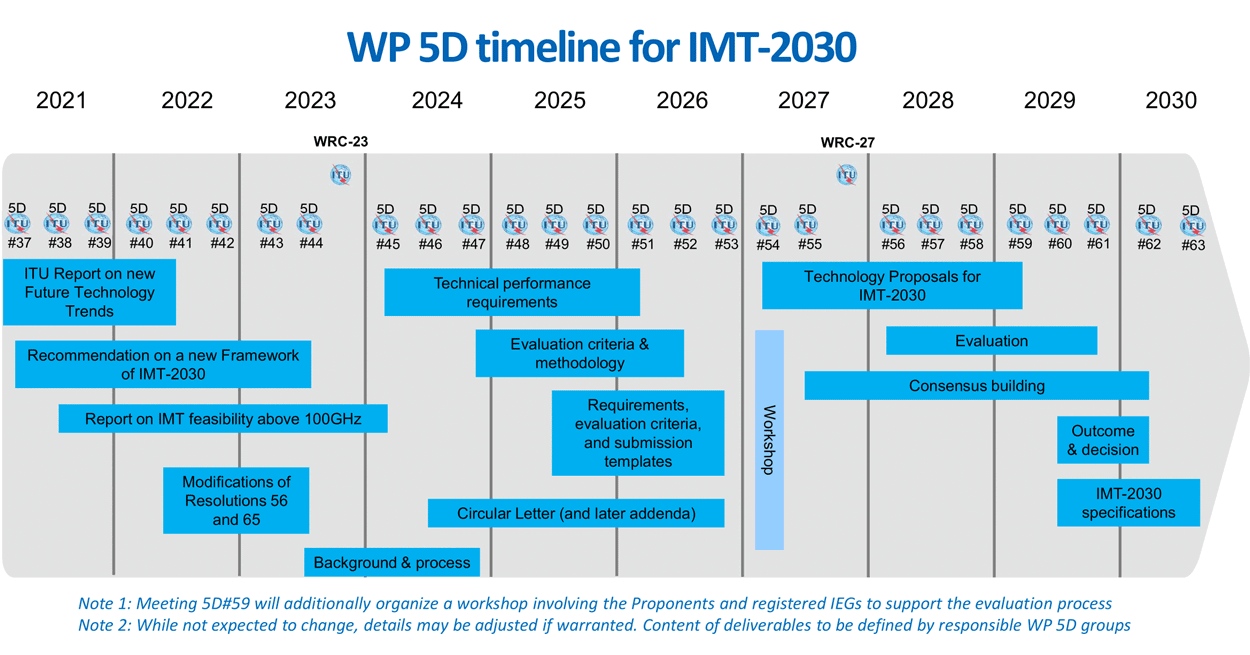
Workshop on “IMT for 2030 and beyond” (14th June 2022)
ITU-R WP 5D held a full-day Workshop on “IMT for 2030 and beyond”, with total 348 participants in an integrated physical and remote participants arrangement. The objective of the Workshop was to provide WP 5D delegates with an overview of ongoing worldwide research activities, initiatives, and views related to future mobile communications targeting 2030 and beyond (details see here).
Fourteen presentations were made from various ITU-R members, external organizations, research projects and academia and in reflecting on the presentations, the following graphic considers keyword theme from each presentation organized within the context of the currently planned sections of the WP 5D working document towards a preliminary draft new Recommendation ITU-R M.[IMT.VISION 2030 AND Beyond]:
FIGURE 1: Keywords in the presentations and mapping with [IMT.vision 2030 AND Beyond] sections

On the road to “IMT towards 2030 and beyond”
ITU-R WP 5D has started the work on “IMT towards 2030 and beyond” by applying the well-proven IMT-process, which has already been implemented for IMT-2000, IMT-Advanced and IMT-2020, resulting in Recommendations ITU-R M.1457, M.2012 and M.2150 respectively.
As one of the targets at the beginning of the process, ITU-R WP 5D developed a new ITU-R Report on “Future Technology Trends”. At the meeting of the parent ITU-R SG 5 in November 2022, this document has been agreed and was published as Report ITU-R M.2516.
The next documents to be developed within ITU-R are:
- ITU-R Recommendation on a new “IMT-2030 Framework” (in former generations named “IMT-Vision”)
- ITU-R Report on “Technical feasibility of IMT in bands above 100 GHz”
Publications
Related activities
Information about ‘IMT towards 2030 and beyond’ will be updated regularly on this webpage and here.
IMT Family History


